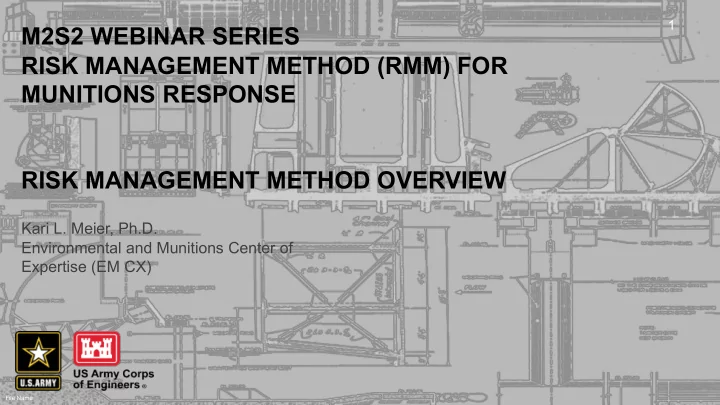

1 M2S2 WEBINAR SERIES RISK MANAGEMENT METHOD (RMM) FOR MUNITIONS RESPONSE RISK MANAGEMENT METHOD OVERVIEW Kari L. Meier, Ph.D. Environmental and Munitions Center of Expertise (EM CX) File Name
TOPICS FUDS Process Property Eligibility Preliminary Assessment Project Categories and Eligibility MMRP-Specific Stuff Project Approval Process There will be a quiz at the end… seriously!
4 EPA RI/FS GUIDANCE “The objective of the RI/FS process is not the unobtainable goal of removing all uncertainty, but rather to gather information sufficient to support an informed risk management decision regarding which remedy appears to be most appropriate for a given site.” 1 1 Guidance for Conducting Remedial Investigations and Feasibility Studies under CERCLA, U.S. EPA, October 1988 Note that the Remedial Investigation and Feasibility Study (RI/FS) share the same objective.
5 MATRIX RELATIONSHIPS 5 Designed to simplify relationships between: – Quantity Matrix 2: Matrix 1: Frequency with – Accessibility Matrix 4: Brings Frequency of Severity of an together all that Encounter – Severity incident is known about UXO or DMM – Sensitivity of Munitions Matrix 3: that may remain Sensitivity of – Site Activities items with consideration of Site Activities
6 SUMMARY OF RISK MANAGEMENT MATRICES (RMM) Likelihood of Encounter Access Conditions (frequency of use) (Amount of MEC versus Access Regular Often Intermittent Rare Conditions) Matrix 1 Category I (Most) Frequent Frequent Likely Occasional Amount of MEC Category II Frequent Likely Occasional Seldom Category III Likely Occa siona l Seldom Unlikely Category IV Occasional Seldom Unlikel y Unlikely Category V Seldom Seldom Unlikely Unl ikely Category VI (Least) Unlikely Unlikely Unlikely U ikely nl Matrix 2 Likelihood of Encounter (from Matrix 1) Severity of Explosive Incident (Severity vs. Likelihood of Frequent Likely Occasional Seldom Unlikely Encounter) Catastrophic/Critical A A B B D Severity Modest B B B C D Minor B C C C D Improbable D D D D D
7 SUMMARY OF RISK MANAGEMENT MATRICES (RMM) Likelihood of Detonation Likelihood to Impart Energy on an Item (Sensitivity vs. Likelihood to Impart High Modest Inconsequential Matrix 3 Energy) High 1 1 3 Sensitivity Moderate 1 2 3 Low 1 3 3 Not Sensitive 2 3 3 Result from Matrix 2 Acceptable and Matrix 4 Unacceptable Site Conditions A B D C 1 Unacceptable Unacceptable Unacceptable Acceptable Result from Matrix 3 2 Unacceptable Unacceptable Acceptable Acceptable 3 Unacceptable Acceptable Acceptable Acceptable
8 EXAMPLE: REMEDIAL ACTION OBJECTIVES RAOs established for each exposure scenario Identify acceptable conditions for each scenario (ft bgs) Vertical Acceptable MRS Remediation Receptors Location Pathways MEC Hazard Baseline Risk Goals Interaction 60mm HE mortar 1.5 Unacceptable (A-2) B-3 or D-2 during hiking, Impact Areas (HUA) Recreational All portions of camping, users impact area 75mm HE hunting 3.0 Unacceptable (A-2) B-3 or D-2 projectile (Non-intrusive) Interaction 60mm HE mortar 1.5 Unacceptable (A-1) B-3 or D-1 Roads and Maintenance during trail trails plus 15 m Crews maintenance 75mm HE buffer 3.0 Unacceptable (A-1) B-3 or D-1 (Intrusive) projectile
10 5 CASE STUDIES Agenda 5 Abstracts / Case Studies 5 Contractors and PDT experiences Paired Case Studies – 10-15 slides each group Unanimous Experience: Forces – Focus on Positives and Challenges discussion to key elements for Review Summary decision logic – Collective Findings – Path Ahead Open Panel for Discussion
QUESTIONS? Kari L. Meier, Ph.D. Kari.l.meier@usace.army.mil
SUMMARY
13 POSITIVES Promotes Communication Promotes DQO Development Standard Process for Various Conditions Data Reliant “Amount of MEC” Differentiates and Justifies Acceptable Vs. Unacceptable Supports Definition of RAOs No (Minimal) ∆$ Keeps NFA on the Table
14 CHALLENGES Terminology Consistency (Guidance) Sensitivity Severity How Relates to Delineating MRSs Type and Amount of MEC Benefits in Remedial Alternatives, Institutional Analysis
15 PATH AHEAD Extended Use Mandatory for FUDS MRSs Voluntary Use in Other Programs EM CX working to develop Guidance to address challenges
QUESTIONS? Kari L. Meier, Ph.D. Kari.l.meier@usace.army.mil
Recommend
More recommend